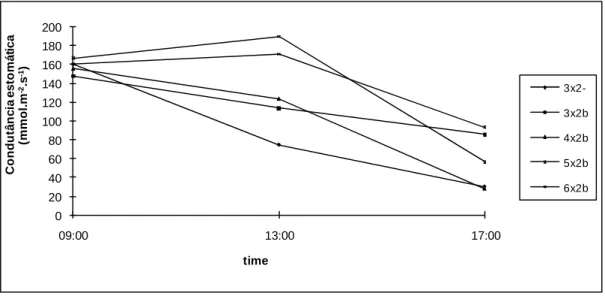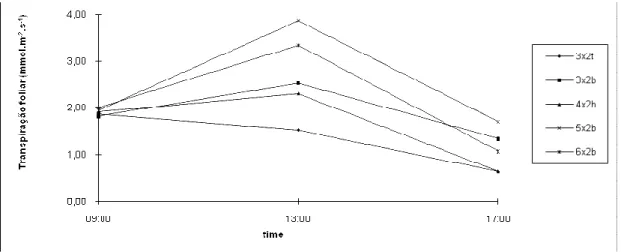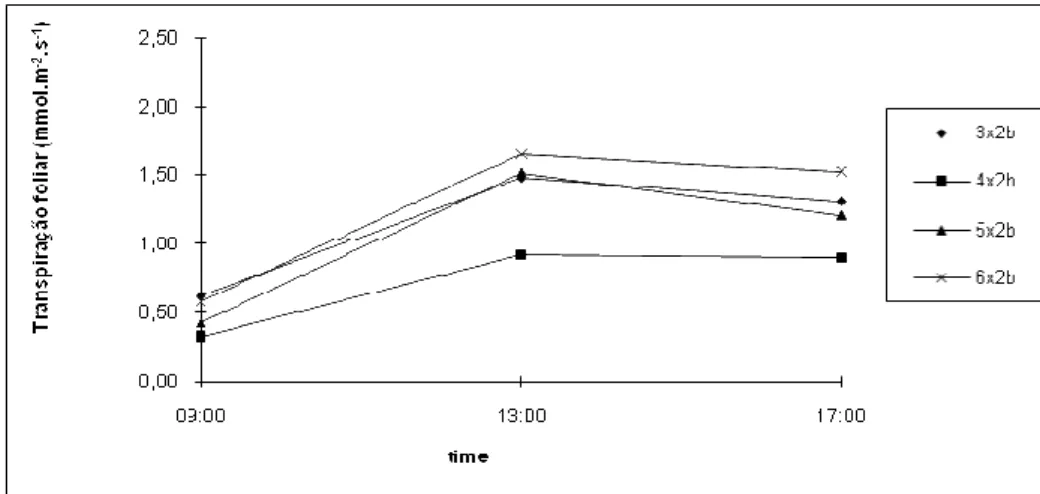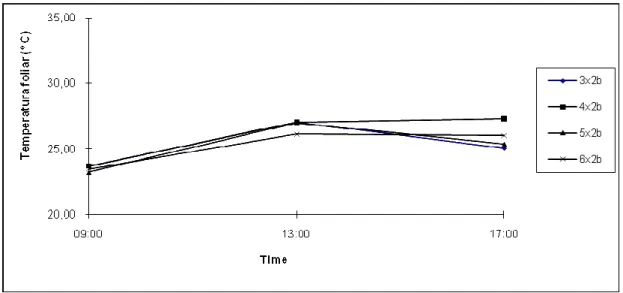Revista Científica Eletrônica de Engenharia Florestal
Revista Científica Eletrônica de Engenharia Florestal
Revista Científica Eletrônica de Engenharia Florestal
Revista Científica Eletrônica de Engenharia Florestal
R
RR
Reeee.C.E.F.
.C.E.F.
.C.E.F.
.C.E.F.
ISSN: 1678-3867
Ano IX - Volume 18 – Número 1 – Agosto 2011 - Garça, SP
Re.C.E.F., v.18, n.1, ago, 2011. 83
HYDRIC RELATIONS IN A CONSORTIUM BETWEEN
EUCALYPTUS AND BRACHIARIA TO THE 39 AND 45 MONTHS OF
AGE IN DIFFERENT SPACING
SILVA, J.M.S. 1; GUERRA, S.P.S. 2; TRABULSI, M.C.M. 3; YAMAJI, F. M. 1 ; PADUA,F.A1 ABSTRACT – (HYDRIC RELATIONS IN A CONSORTIUM BETWEEN EUCALYPTUS AND BRACHIARIA TO THE 39 AND 45 MONTHS OF AGE IN DIFFERENT SPACING). The hydric relations of the consortium between Eucalyptus and Brachiaria decumbens, in declivous land, had been evaluated in populations to the 39 and 45 months of age established in the spacing 3x2m, 4x2m, 5x2m and 6x2m. The experiment was installed in experimental delineation randomized blocks with four repetitions. The hydric relations for the E. grandis have demonstrated that plants established in the amplest spacing had presented one better hydric status and the consortium in these conditions, didn’t damage the tree species due to the root systems of the plants because of it is exploring different horizons of the ground. The production of the Brachiaria decumbens varied with the occupation of the ground and shadow promoted for the E. grandis, influencing in the hydric aspects resulting in bigger production in the spacing 6x2m, with 2.45 times the biomass gotten in the spacing 3x2m.
Key words: hydric relations, eucalyptus, brachiaria.
RESUMO – (RELAÇÕES HÍDRICAS EM UM CONSÓRCIO DE EUCALIPTO E BRAQUIÁRIA AOS 39 E 45 MESES DE IDADE COM DIFERENTES ESPAÇAMENTOS). As relações hídricas do consórcio entre Eucalyptus e Brachiaria decumbens, em solo com declive, foram avaliadas em populações aos 39 e 45 meses de idade estabelecidas no espaçamento 3x2m, 4x2m, 5x2m e 6x2m. O experimento foi instalado em delineamento experimental de blocos ao acaso com quatro repetições. As relações hídricas para o E. grandis demonstraram que as plantas estabelecidas no espaçamento mais amplo apresentaram um melhor estado hídrico e o consórcio nestas condições não danifica as espécies arbóreas, devido ao sistema radicular das plantas que explora diferentes horizontes do solo. A produção da Brachiaria
decumbens variara com a ocupação do solo e com a sombra promovida pelo E. grandis, influenciando nos
aspectos hídricos e resultando em uma maior produção no espaçamento 6x2m, com 2,45 vezes a biomassa obtida no espaçamento de 3x2m.
Palavras-chave: relações hídricas, eucalipto, braquiária.
1 Prof. Doutor da Universidade Federal de São Carlos- Campus Sorocaba;
2 Prof. Assistente Doutor, Departamento de Gestão e Tecnologia Agroindustrial, Universidade Estadual Paulista –
FCA/UNESP (ssguerra@fca.unesp.br);
3 Engenheira Florestal, Departamento de Gestão e Tecnologia Agroindustrial Universidade Estadual Paulista –
Re.C.E.F., v.18, n.1, ago, 2011. 84
1. INTRODUCTION
The species of the Eucalyptus genus, considered of fast growth in tropical regions, allow wood attainment in short rotations. Their wood can be used for sawmill, cellulose, coal and other uses in industries and rural properties.
Using this consortium makes a better field utilization and ecologic conditions for farmers and companies.
Brachiaria decumbens had been used because it shows a high biologic nitrogen fixing rates, overcoming the organism’s soil competition for this element. For this reasons, the consortium between E. grandis and B. decumbens could be a practicable alternative (CARVALHO et al., 1997).
The shadow of Eucaliptus reduces the grazing growth; however benefit the animals, providing comfort for them. Add to that, the wood usage in rural properties has a wide range of application.
The aim of this research was evaluates hydric parameters in a consortium between E. grandis following different spacing and B. decumbens in order to improve natural resources usage.
2 MATERIAL AND METHODS
2.1 Hydric Relations Evaluated
The experiment was realized on a sloping down relief, 30% declivous and 450 m above sea level.
Eucalyptus planting season was in January and grass sowing season on February. Soil was classified as being Latossolo Vermelho Amarelo. Grass seed was sowed in lines spaced 20 cm each one and 1 meter of each eucalyptus seedlings. E. grandis seedlings remained clear and without grass competition during the first two years. The experimental design was randomized block with four replications for E. grandis: 3x2 m, 4x2 m, 5x2 m, 6x2m, with 1,666, 1,250, 1,000 and 833 trees per hectare, respectively, in consortium with B. decumbens.
The evidence was based in a treatment with 3x2 m E. grandis without consortium. Two boundary lines were left in order to create a protection border.
Physiologic parameters were measured at 39 and 45 month age for E.
grandis and B. decumbens. Three
measurements were done at 9:00 am, 1:00 pm and 5:00 pm for leaf temperature, leaf
Re.C.E.F., v.18, n.1, ago, 2011. 85 transpiration and stomata conductance. To
determinate those parameters, three leaves per treatment and three leaves per tree were taken being used a stationary porometer model LI-1600, LICOR in the leave surface total expanded, in the intermediate position in the crown of the trees and, in leaves completely developed of B. decumbens. For the evaluation of hydric potential, a bomb of pressure (SCHOLANDER et al., 1965) in the same schedules of the previous measurements was used.
3 RESULTS AND DISCUSSION
3.1 Hydric Potential
E. grandis hydric potential (Figure 1 and 2) showed higher values at the beginning and at the end of the day, and smaller values at 1pm, probably caused by a displacement between transpiration and water absorption. In the other hand, also at 1:00 pm was observed the highest air temperature resulting in a high air moisture deficit added to the increased leaf temperature. The hydric potential displacement is related with the water tension inside the tree. During the evaluations in april and october an analog
pattern was found as GOMES (1994), LELES (1995) e OLIVEIRA NETO (1996) for E. camaldulensis, E. pellita and E. urophylla at Cerrado environment.
The recovery hydric status capacity at the end of the day had varied during the year. In april, at the end of the raining season, this recovery capacity occurred faster because the high soil moisture. In october when the soil moisture is not so high, the recovery hydric status was slow. No matter what season, the plants recover their hydric potential at night.
In april, in all spacing, E. grandis and B. decumbens have their hydric potential recovered in the evening, showing the availability of water demand.
In October, with less availability of water in the soil, the changes in hydric potential values were supposed to be higher, and the reduction meaningful. The hydric potential recover is low and it values, at 9 in the morning, are reduced, keeping reduced until 1pm.
E. grandis hydric potential, in spacing 3x2m, in consortium with B. decumbens, had been more raised than the plantation of E. grandis, in the same spacing, in both seasons, (Figures 1 and 2). This result is possibly because of the B. decumbens efficient cover in soil, reducing
Re.C.E.F., v.18, n.1, ago, 2011. 86 the flow of water by the declined area, and
increasing the infiltration of water in the soil profile (REIS and REIS, 1995).
The hydric potential values for B.
decumbens (figures 3 and 4) follow the same
standard of E. grandis, with low potential hydric
values, what means that is a specie characteristic when in consortium. Brachiaria has been surviving either in the shadow of Eucaliptus. It seems that the spread light into the crown of the trees is sufficient for growing B. decumbens, even in closed spacing.
-2,2 -2,0 -1,8 -1,6 -1,4 -1,2 -1,0 -0,8 -0,6 -0,4 9am 1pm 5pm H y d ri c P o te n c ia l o f th e le a f (M p a ) Time 3x2t 3x2b 4x2b 5x2b 6x2b
(t = plant control, b = consortium with brachiaria)
Figure 1 – Hydric potential of E. grandis, in consortium with B. decumbens in April, 39 months of age in different
spacing.
(t = plant control, b = consortium with brachiaria)
Figure 2 - Hydric potential of E. grandis in consortium with B. decumbens in october, 45 months of age, in different
Re.C.E.F., v.18, n.1, ago, 2011. 87
Figure 3 - Hydric potential of B. decumbens, in consortium with E. grandis, in april, with 39 months of age, in
different spacing.
Figure 4 - Hydric potential of B. decumbens in consortium with E. grandis, in october, with 45 months of age, in
different spacing.
3.2 Stomata Conductance
The stomata conductance of eucalyptus’s leave in the consortium (Figures 5 and 6), is showing the movement of the stomata and the capacity of water, in
different periods around the year and spacing. It’s higher in large spacing. These results had been seen by GOMES (1994), for E. pellita, E. urophylla e E. camaldulensis, in the region of Minas Gerais’ Cerrado. In
Re.C.E.F., v.18, n.1, ago, 2011. 88 April, the quantity of water in the soil is
higher than in october, when the plants are supposed to reduce the waste of water. When
the stomata are closed, the cuticle conductance is the main function (REIS and HALL, 1986). 0 20 40 60 80 100 120 140 160 180 200 09:00 13:00 17:00 C o n d u tâ n c ia e s to m á ti c a (m m o l. m -2.s -1) time 3x2-3x2b 4x2b 5x2b 6x2b
(t=plant control, b = consortium with brachiaria)
Figure 5 - Stomata conductance of E grandis’ leave in consortium with B. decumbens, in april, in different spacing.
(t= plant control, b = consortium with brachiaria)
Re.C.E.F., v.18, n.1, ago, 2011. 89
B. decumbens’ values of stomata
conductance (Figure 7 and 8), are lower than the eucalyptus and, there were not reduced at 1pm, neither in april nor in october. The plants located in the largest spacing had reached higher values at 1pm,because of the roots stratification and the water in the soil.
In general, eucalyptus’s roots get deep vertically, close to the surface of the tree and the thin roots. Both roots explore the same area of soil. REIS and REIS (1995) point out that the understory grass can keep the soil humid, in consequence of its low conductance relation with the eucalyptus properties.
0 10 20 30 40 50 60 70 80 90 09:00 13:00 17:00 s to m a ti c c o n d u c ta n c e time 3x2b 4x2b 5x2b 6x2b
Figure 7 - Stomata conductance of B. decumbens in consortium with E. grandis, in april, in different spacing.
Re.C.E.F., v.18, n.1, ago, 2011. 90
3.3. Leaf Transpiration
The hydric stress of the soil and plant reduces the transpiration in consequence of the stomata closing. Leaf transpiration is associated with the gradient of water vapor concentration in the internal surface of evaporation. The resistance to the air, water vapor transport, and or, in the neighborhoods of the cells in the interior of the leaf constitutes restriction to the transpiration process of the plant. The plant minimizes the water uses, with the stomata coordinated movements, not compromising its vital process.
The transpiration of the plants of the consortium (Figure 9 to 12) has varied in accordance with different spacing and times.
In general, the leaf transpiration was higher at 1pm, reducing in the evening. LELES (1995, also had observed a similar reply studying E. camaldulensis and E. pellita, in the region of Joao Pinheiro – MG. With the increase of the air temperature, the leaf temperature increases at 1pm, raising the difference between the temperatures. The loss of water, in this period, reduces the leave hydric potential. The competition in the larger spacing is lower because it’s more water and the leave transpiration is higher. Eucalyptus’s leave transpiration (Figures 9 and 10) was higher during the measurements, in spacing 3x2m in consortium with B. decumbens in relation to the treatment without grass, suggesting exist more water in the soil of the consortium.
(t= plant control, b = consortium with brachiaria)
Re.C.E.F., v.18, n.1, ago, 2011. 91
(t= plant control, b = consortium with brachiaria)
Figure 10 - Leaf transpiration of the consortium between E. grandis and B. decumbens, in october, in different
spacing.
It’s possible that the effective soil covering by the grass has been important to prevent the water impact and facilitate its fast infiltration. The plants absorb the water and avoid the carry of residues and particles, practically annulling erosion in this declined areas.
Leave transpiration of B. decumbens
(Figures 11 and 12) has presented lower values than E. grandis, however, the standard of the curves were similar. In April, the higher transpiration was at 5pm, the water in soil was enough not demanding that B. decumbens develops the control of loss of water.
Re.C.E.F., v.18, n.1, ago, 2011. 92
Figure 12 - Leaf transpiration of B. decumbens in consortium with E. grandis, in October, in different spacing.
In October, the transpiration values have started reducing again at 5pm, because of the stomata closing. The grass in consortium with the eucalyptus, in the spacing 5x2 and 6x2m, has showed high values of transpiration, as in the Eucalyptus’s evaluation, probably because of the higher availability of water in the soil of the large spacing between the plants.
3.4 Leaf Temperature
There was no difference of leaf temperature in the consortium between all the spacing (Figures 13 to 16).
Similar results could be seen by
LELES (1995) and GOMES (1994) for
E. camaldulensis, E. pellita e E. urophylla, in the region of Cerrado.
The leaf temperature is important to quantify the energy of the crown of the trees and it’s influenced directly for the transpiration rate; when it raises, the leave reduces the temperature. In October, the transpiration for both species (figures 14 to 16) was lower because of the hydric stress caused by the water deficit in the soil, raising the temperature of the leave.
The plants of eucalyptus, in the spacing 3x2m, not in the consortium with grass, had presented, in the measurements of april and october, the leave temperature raising until 5pm, because of the low
Re.C.E.F., v.18, n.1, ago, 2011. 93 refrigeration on the stressed time. However,
in the consortium with grass, the plants of eucalyptus had presented the increasing of the temperature at 1pm and reducing at 5pm, in april, proving the importance of the grass covering, which maintains the humidity of the soil.
The plants of eucalyptus, in the spacing 3x2m, not in the consortium with
grass, had presented, in the measurements of april and october, the leave temperature raising until 5pm, because of the low refrigeration on the stressed time. However, in the consortium with grass, the plants of eucalyptus had presented the increasing of the temperature at 1pm and reducing at 5pm, in april, proving the importance of the grass covering, which maintains the humidity of the soil. 20,00 25,00 30,00 35,00 09:00 13:00 17:00 T e m p e ra tu ra f o li a r (º C ) Time 3x2t 3x2b 4x2b 5x2b 6x2b
(t= plant control, b = consortium with brachiaria)
Figure 13 – Leaf Temperature of E. grandis, in consortium with B. decumbens, in April, in different spacing.
When the leave transpiration reduces because of the closing stomata, leave temperature raise, in consequence of the incidence of radiation and heat exchange. In some cases, the raise of leave temperature is followed for the transpiration reducing. B. decumbens’ temperature leave
values had been higher in the beginning compared with E. grandis, possibly because in this specie the transpiration is lower than in eucalyptus. The leave allow accumulate more energy and raise the temperature.
Re.C.E.F., v.18, n.1, ago, 2011. 94 20,00 25,00 30,00 35,00 09:00 13:00 17:00 T e m p e ra tu ra f o li a r (º C ) Hora do Dia 3x2t 3x2b 4x2b 5x2b 6x2b
(t= plant control, b = consortium with brachiaria)
Figure 14 – Leaf Temperature of E. grandis, in consortium with B. decumbens, in october, in different spacing.
Re.C.E.F., v.18, n.1, ago, 2011. 95
Figure 16 – Leaf temperature of B. decumbens in consortium with E. grandis, in October, in different spacing.
4 DISCUSSION AND CONCLUSIONS
To summarize, the goal of the study was to determinate the viability of the consortium between Eucalyptus grandis and Brachiaria decumbens, in declivous relief in different spacing 3x2m, 4x2m, 5x2m and 6x2m. The experimental design was randomized block with four replications and the spacing 3x2m without consortium, considered plant control. The hydric relations were quantified between the species.
The hydric relations for the E. grandis have demonstrated that plants established in the amplest spacing have presented one better hydric status and the
consortium in this declivous area didn’t damage this specie, probably because of it is exploring different horizons of the ground. In the reduced spacing, as in 3x2 m, the competition for water and light was responsible for the reduction of B. decumbens raise.
5 REFERENCES
CARVALHO, M.M., SILVA, J.L.O., CAMPOS JUNIOR., B.A. Produção de matéria seca e composição mineral da forragem de seis gramíneas tropicais estabelecidas em um sub-bosque de angico vermelho. R. Bras. Zootec. V.26, n.2, p.213-218, 1997.
CASTRO, C.R.T. Tolerância de gramíneas forrageiras tropicais ao sombreamento. Viçosa: UFV, 1996. 247p. Tese (Doutorado
Re.C.E.F., v.18, n.1, ago, 2011. 96 em Zootecnia) - Universidade Federal de
Viçosa, 1996.
FERREIRA NETO, P.S. Comportamento inicial do Eucalyptus grandis W. Hill ex. Maiden em plantio consorciado com leguminosas na região do médio Rio Doce, Minas Gerais. Viçosa: UFV, 1994. 92p. Dissertação (Mestrado em Ciência Florestal) - Universidade Federal de Viçosa, 1994.
GOMES, R.T. Efeito do espaçamento no crescimento e nas relações hídricas de
Eucalyptus spp na região de cerrado de
Minas Gerais. Viçosa: UFV, 1993. 85 p. Dissertação (Mestrado em Ciência Florestal) - Universidade Federal de Viçosa, 1994.
LELES, P.S.S. Crescimento, alocação de biomassa e distribuição de nutrientes e uso de água em E. camaldulensis e E. pellita sob diferentes espaçamentos. Viçosa: UFV, 1995. 133p. Dissertação (Mestrado em Ciência Florestal) - Universidade Federal de Viçosa, 1995.
OLIVEIRA NETO, S.N. Biomassa, nutrientes e relações hídricas em
Eucalyptus camaldulensis Dehn. em
resposta à adubação e ao espaçamento. Viçosa: UFV, 1996. 131p. Dissertação (Mestrado em Ciência Florestal) - Universidade Federal de Viçosa, 1996.
REIS, G.G, HALL, A.E. Resistência à desidratação de E. camaldulensis Dehn com restrição de sistema radicular. Revista Árvore, v.10, p.168-180, 1986.
REIS, G.G., REIS, M.G.F. Competição por luz, água e nutrientes em povoamentos florestais. In: SIMPÓSIO BRASILEIRO DE PESQUISA FLORESTAL, 1, 1993, Belo Horizonte. Anais... Belo Horizonte, p. 161-172, 1993.
SCHOLANDER, P.F., HAMMEL, H.T., BRADSTREET, E.D., HEMMINGSEN, E.A. Sap pressure in vascular plants. Science, v.148, p.339-346, 1965.
A Revista Científica Eletrônica de Engenharia Florestal é uma publicação semestral da Faculdade de Agronomia e Engenharia Florestal – FAEF e da Editora FAEF, mantidas pela Associação Cultural e Educacional de Garça – ACEG. Rod. João Ribeiro de Barros km 420 – estrada de acesso à Garça km 1 – CEP 17400-000 – Tel. (14) 3407-8000. www.revista.inf. br/florestal - www.faef.edu.br - www.editorafaef.com.br – florestal@faef.br







